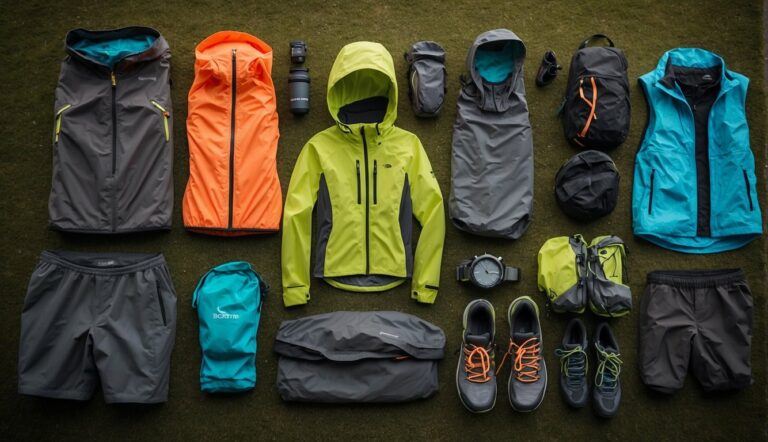Elevation Changes: Mastering Uphill and Downhill Trail Running Techniques
Trail running presents unique challenges unlike those found in road running, particularly when it comes to elevation changes. As an experienced running coach certified by the United Endurance Sports Coaching Academy (UESCA), I’ve guided numerous runners through the rigors of the trails. Mastering the art of trail running requires an understanding of how to effectively and safely navigate both uphill and downhill sections.
When facing an uphill, conserving energy while maintaining a steady pace is key. I teach runners to use shorter strides and a consistent rhythm to ascend without overexertion. Conversely, when running downhill, control is essential to prevent injuries. It’s important to lean slightly forward, use your arms for balance, and let gravity assist your descent, whilst being mindful of the increased impact on your legs.
Elevation changes on the trail test a runner’s adaptability, strength, and endurance. By preparing for these changes, trail runners can enhance their performance and enjoy the benefits of the natural terrain. My coaching methodology emphasizes efficiency, injury prevention, and technique adaptability for all elevation challenges on the trails.

Mastering the Uphill as a Trail Runner
In uphill trail running, technique and strength are paramount. Adopting the right form will help maintain balance and conserve energy, while targeted strength training can enhance muscle power necessary for steep climbs. Pacing is crucial for managing energy reserves throughout the ascent.
Optimizing Your Uphill Technique
When tackling an ascent, it’s essential to focus on maintaining a short, quick stride to tackle steep hills effectively. This approach helps in balancing and maintaining momentum. Form is crucial when running uphill:
- Lean forward slightly from the hips, not the waist.
- Keep shoulders back and head up to ensure efficient oxygen flow.
- Arm swing should be purposeful and in sync with leg movement.
- Footstrike should be on the mid-foot to distribute force evenly.
Strength Training and Conditioning for Uphills
Strength plays a pivotal role when confronting elevation gain. A structured strength training regimen can make a significant difference:
Leg Strength:
- Squats and lunges: Focus on building quadriceps and glutes.
- Calf raises: Improve push-off power.
Core Stability:
- Planks and bridges: Enhance balance and stability.
- Core rotations: Refine muscle coordination during running.
These exercises should be incorporated into weekly workouts to build uphill running prowess.

Strategic Pacing and Energy Conservation on Ascents
Effective pacing allows for energy conservation throughout climbs. Different elevations require different approaches:
- For moderate inclines, maintain a steady, sustainable pace.
- In cases of steep hills, switch to a power hike to preserve energy.
Here’s a quick pacing strategy chart:
| Incline Type | Strategy |
|---|---|
| Moderate | Steady pace; limit overexertion |
| Steep | Power hike; use arms for leverage |
By honing technique, building strength, and pacing strategically, I equip runners with the tools they need to master uphill challenges.
Navigating the Downhill as a Trail Runner

When tackling downhill running, mastering technique is crucial for minimizing impact force and maximizing efficiency. It’s important to focus on form, pay attention to the terrain, and use gravity to your advantage while engaging the quad and glute muscles for better control.
The Science of Downhill Running
Downhill running requires a unique approach as compared to running on flat or uphill terrain. On descents, gravity naturally increases your speed, but without proper technique, this can lead to uncontrolled momentum and higher impact forces on your body, especially on technical terrain. It’s essential to adapt your form to manage these forces effectively. Doing so involves:
- Keeping your center of gravity slightly forward.
- Taking shorter strides to reduce the braking effect and impact on the quad muscles.
- Allowing your feet to strike the ground directly beneath your body to avoid overstraining the legs.
Improving Traction and Stability on Descents
Maintaining traction and stability when running downhill, particularly on loose or technical terrain, is a combination of footwork, body position, and muscle engagement. To navigate downhill sections safely:
- Footwork: Use a midfoot strike to maintain traction, as heel striking can lead to slipping and increased impact.
- Body Position: Lean forward from the ankles, not the waist, to align with gravity and maintain balance over uneven obstacles.
- Muscle Engagement: Activate your core and glute muscles to stabilize your stride and mitigate the high impact on the quad muscles.
By incorporating these techniques into your downhill running practice, you’ll improve control, reduce the risk of injury, and potentially enhance your performance on descents.
Adapting to Varied Terrain

Trail running demands adaptability to an ever-changing environment. Mastering varied terrain is key to efficient and safe trail running.
Coping with Technical Trails
Technical trails feature obstacles like rocks and roots that challenge your foot placement and stability. I always emphasize the importance of maintaining a center of gravity over your feet to aid in balance. Additionally, it’s crucial to keep your gaze a few feet ahead to anticipate and react to technical sections. Here’s a quick guideline to tackle technical terrain:
- Eyes Forward: Look ahead to plan your steps.
- Short Strides: Use a shorter stride to maintain balance.
- Quick Feet: Lift your feet swiftly to clear obstacles.
Adjusting Stride and Posture on Different Surfaces
Adapting your stride and posture on various surfaces ensures efficiency and reduces the risk of injury. On smooth trails, a longer stride is more effective, but as the surface becomes more uneven, a shorter, quicker stride with higher knee lift helps maintain momentum. On steep inclines, lean slightly forward from your ankles, not your waist. For descending, my tip is to lean back a bit to control descent, but maintain a slight forward lean to keep the momentum. Here’s a simple stride adjustment chart:
| Surface Type | Stride Length | Posture Adjustments |
|---|---|---|
| Smooth Trail | Longer Strides | Upright Posture |
| Rocky Path | Shorter Strides | Slight Forward Lean |
| Steep Incline | Short, Powerful Strides | Lean From Ankles |
| Downhill | Controlled, Quick Strides | Lean Back Slightly |
Maintaining a responsive approach to terrain changes is the cornerstone of effective trail running. Keeping these strategies in mind will allow for a smoother transition through the varied landscapes encountered on the trails.
Training Plans and Performance Metrics

When it comes to tackling the challenges of elevation changes in trail running, developing a strategic training plan is crucial. Utilizing performance metrics can effectively monitor and evaluate your running economy and overall progress.
Tailored Workouts for Elevation Change Proficiency
To excel at uphill and downhill running, I recommend incorporating specific workouts into your training routine. For uphill proficiency, a blend of high-intensity interval training (HIIT) will enhance your strength and endurance. Traction plays a vital role, and workouts should simulate the uneven terrain for muscle adaptation. Downhill training, on the other hand, should focus on eccentric leg exercises to improve control and reduce impact forces.
Example Uphill Workout:
- Warm-up: 10-15 minutes easy jogging
- Main Set:
- 5 x 2-minute hill repeats at hard effort followed by downhill jog recovery
- 5 x 1-minute steep hill sprints with full recovery
- Cool down: 10-15 minutes easy jogging
Example Downhill Workout:
- Warm-up: 10-15 minutes easy jogging
- Main Set:
- 8-10 x 1-minute downhill runs at a controlled, fast pace
- Walking back uphill as recovery
- Cool down: 10-15 minutes easy jogging
Monitoring Progress with Metrics and Technology
Metrics and technology are fundamental for tracking performance improvements and tweaking the training regimen accordingly.
Distance and heart rate are primary metrics, which can be accurately measured with a reliable GPS watch. Monitoring heart rate ensures you’re training at the correct intensity, while distance tracking helps quantify the elevation gain and loss during workouts.
Key Performance Metrics:
- Heart Rate: To track workout intensity and recovery
- Distance: Important for understanding volume and training adaptations over time
- Running Economy Values: Indicators of how efficiently you use energy at different paces
By keeping a close eye on these metrics, I can adjust my training plans to target weak areas and optimize performance, ensuring my running economy is at its best when approaching race day.
Safety, Gear, and Trail Etiquette
In trail running, the terrain dictates strict attention to safety and gear selection. Understanding trail etiquette ensures a responsible and enjoyable experience for everyone sharing the path.
Choosing Appropriate Footwear and Equipment
Footwear is the cornerstone of trail running gear, with my preference for shoes offering a balance between grip, support, and cushioning to tackle varying terrain without compromising on comfort. It’s important to select shoes based on the trail’s specific conditions like mud, rocks, or roots.
When considering additional equipment, hydration packs, gps watches, and running poles may be beneficial. Hydration packs ensure water is accessible, particularly on longer, isolated runs or in warmer climates. Poles can enhance stability during steep ascents and descents, especially in technical trail races. Always consider weight and comfort, as heavy or cumbersome gear can lead to fatigue and increase injury risk.
- Essential Gear for Trail Running:
- Footwear with adequate grip
- Hydration packs for water accessibility
- Lightweight and breathable clothing
- GPS watches for navigation
- Running poles for stability in technical terrain
Trail Running Safety and Injury Prevention
Trail running requires attentiveness to prevent injuries like ankle sprains or falls. On uneven terrain, I recommend a shorter, more controlled stride, and scanning the path ahead to anticipate obstacles. Awareness of wildlife and trail conditions is also crucial for safety. Carry some calories, like energy gels or bars, to maintain energy levels, and know how to respond to wildlife encounters without panic.
- Injury Prevention and Safety Checklist:
- Mind the terrain: Scan ahead for obstacles like rocks and roots.
- Adjust stride: Use shorter, more controlled steps on uneven ground.
- Wildlife encounters: Stay calm, make noise to deter animals, and give them space.
- Nutrition: Bring calories in the form of gels, bars, or fruit to maintain energy.
While practicing these safety measures, also respect the trail and fellow runners. Yield to others where the trail narrows, respect trail closures, and stay on marked paths to minimize environmental impact. Trail etiquette preserves the trail running experience for all and helps foster a respectful outdoor community.






